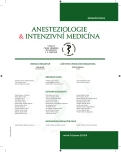Anaesthesia for irreversible electroporation (IRE) prostatectomy: Reversal of neuromuscular blockade with sugammadex vs neostigmin. Retrospective study
Authors:
Herold Ivan 1; Sittová Naděžda 1; Čurdová Marcela 1; Kolombo Ivan 2; Pabišta Richard 3; Adamus Milan 4
Authors‘ workplace:
Anesteziologicko-resuscitační oddělení, Oblastní nemocnice Mladá Boleslav, a. s.
1; Centrum robotické chirurgie a urologie, Nemocnice Na Homolce, Praha
2; Urologické oddělení, Oblastní nemocnice Mladá Boleslav, a. s.
3; Klinika anesteziologie, resuscitace a intenzivní medicíny, FN a LF UP v Olomouci
4
Published in:
Anest. intenziv. Med., 24, 2013, č. 4, s. 230-236
Category:
Anaesthesiology - Original Paper
Overview
Objective:
Assessment of factors influencing the reversal of neuromuscular blockade with sugammadex (S) and neostigmin (N) in IRE prostatectomy requiring deep neuromuscular block until the end of surgery.
Type:
Retrospective study, analysis of anaesthesia charts.
Setting:
Department of Urology, Department of Anaesthe-siology and Intensive Therapy.
Materials and methods:
During a 5-month period (November 2011–March 2012) IRE prostatectomy were performed in 35 men in balanced general anaesthesia with rocuronium. At the end of surgery, S 200 mg (BRIDION) or N (NEOSTIGMIN) were administered for the reversal of deep block (TOF-count 0, PTC ≥ 5) or moderate block (TOF-count ≥ 1) respectively. We analysed the relation of the reversal to the rocuronium admini-stration: the intubation dose, total dose (absolute, per kg of body weight, number of supplementing boluses), duration of anaesthesia and ASA using non-parametric Mann Whitney and Fischer exact tests. Results are presented as mean values.
Results:
Sugammadex 200 mg (2.21 mg/kg) was administered in 22 (63%) patients with deep block (BRIDION group), neostigmin (0.027 mg/kg) in 13 (37%) patients with moderate block (NEOSTIGMIN group). Comparing to NEOSTIGMIN, higher doses of rocuronium – absolute dose (82.5 vs 65 mg, p = 0.001) and dose/kg bw (0.85 vs 0.69 mg/kg, p = 0.018) were given, the number of rocuronium boluses was higher (p = 0.013) and the anaesthesia was longer (100 vs 90 min, p = 0.044) in the BRIDION group. A dose of S 200 mg was sufficient in 20 patients (91 %) for block reversal. In 2 patients with a lower sugammadex dose (< 1.6 mg/kg), a supplement dose of 100 mg was required for complete block recovery after 3.5 min.
Conclusion:
In IRE prostatectomy, rocuronium-sugammadex combination appears to be a cost-effective strategy. A standard dose of 200 mg sugammadex at the end of surgery might be insufficient in obese patients (in doses < 1.6 mg/kg).
Keywords:
neuromuscular blockade – akcelerometry – reversal –neostigmin–sugammadex–prostatectomy–irreversible electroporation
Sources
1. Haimowitch, L. Interest grows with least – invasive approaches taken by interventional oncology practitionares. Biomedical Bussiness and Technology, 2008, 31, p. 5–8.
2. Biki, B., Mascha, E., Moriarty, D., Fitzpatrick, J., Sessler, D., Buggy D. Anesthetic technique for radical prostatectomy surgery affects cancer reccurence. Anesthesiology, 2008, 109, p. 180–187.
3. Rubinski, B. Irreversible electroporation in Medicine. Technology in Cancer Research and Treatment, 2007, 6, p. 255–259.
4. Nikolski, V., Efimov, P. Electroporation of the heart. Europace, 2005, 7, p. S146–S157.
5. Onik, G., Mikus, P., Rubinsky, B. Irreversible electroporation: implications for prostate ablation. Technology in Cancer Research and Treatment, 2007, 6, p. 295–300.
6. Esser, A., Smith, K., Gowrishankar, T., Weaver, J. Towards solid tumor treatment by irreversible electoporation: Intrinsic redstributionof fileds and currents in tissue. Technology in Cancer Research and Treatment, 2007, 6, p. 261–273.
7. Rubinsky, J., Onik, G., Mikus, P. et al. Optimal parameters for the destruction of prostate cancer using irreversible electroporation. J. Urol., 2008, 180, p. 2668–2674.
8. Ball, C., Thomson, K. R., Kavnoudias, H. Irreversible electroporation: a new challenge in „out of operating theater“ anesthesia. Anesth. Analg., 2010, 110, p. 1305–1309.
9. Málek, J., Šturma, J., Janík, V., Kurzová, A. Anesteziologická problematika CT navigované ireverzibilní elektroporatizace(přístroj NanoKnife™). Anest. Intenziv. Med., 2013, 2, p. 83–89.
10. Kolombo, I. Nová technologie miniinvazivní terapie maligních tumorů – NanoKnife® [cit. 2013-04-24]. Dostupný na:http://www.sab-medical.com/nano-knife.php.
11. Brausi, M., Gibert, G., Botiicelli, L., Di Gregio, C. Irreversible electroporation, a novel technique for focal ablation of prostate cancer (PCA): Results of a interim pilot safety study in low risk patients with PCA. Eur. Urolog. Suppl., 2011, 10, p. 300.
12. Eleveld, D. J., Kuizenga, K., Proost, J. K., Wierda, J. M. A temporary decrease in twitch response during reversal or rocuronium-induced muscle relaxation with small dose of sugammadex. Anesth. Analg., 2007, 104, 3, p. 582–584.
13. Fuchs-Buder, T. Less is not always more: sugammadex and the risk of underdosing. Eur. J. Anaesthesiol., 2010, 27, 10, p. 849–854.
Labels
Anaesthesiology, Resuscitation and Inten Intensive Care MedicineArticle was published in
Anaesthesiology and Intensive Care Medicine

2013 Issue 4
Most read in this issue
- Development of the specialty of anaesthesiology and resuscitation at Kladno Hospital in the memoirs of Dr Vladimir Lemon, the first head of the department
- Immune homeostasis (deregulation) in sepsis and septic shock
- Anaesthesia for irreversible electroporation (IRE) prostatectomy: Reversal of neuromuscular blockade with sugammadex vs neostigmin. Retrospective study
- Desflurane facilitates a successful wake-up test in scoliosis surgery in children. Case report
